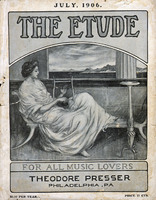BY F. C. R.
It is curious what a tendency there is for a teacher to run into a rut in the selection of the same pieces over and over, year after year. This grows out of two circumstances: The well-known pieces in the list have been sifted out of a large number, and from their attractiveness and sterling qualities accomplish the two things for which pieces are commonly given. Namely, they please the pupil and exercise an influence upon the taste and musical life. In the nature of the case a teacher learns to adapt the pieces of his standard repertory to the needs of individual pupils. With new pieces there is difficulty. In the first place one is not so sure about the difficulties in them, for the essence of difficulty is far from having been accurately determined in piano music. A certain piece appears to the pupil impossible; another pupil takes it up and likes it, and plays it well. What was the difficulty in the first case? Was it due to lack of proper explanation of the piece on the teacher’s part?
There are many teachers who, if they would honestly confess the truth about their teaching, would acknowledge that their pupils were working the same old pieces and the same round of technics and etudes each year; that many of their pupils had come to a standstill, had lost interest in music, did poorer practice than ever; that things were running in a well and deeply worn rut. These teachers need a new fund of fresh ideas, need to have their eccentricities rubbed off by contact with a lot of earnest and bright teachers, such as are invariably found at a summer school of music. They need to see and realize what an ungainly and bony old skeleton their “hobby” really is. The sharp contrasts that they will meet at such a school gives them eyes to see themselves as others see them. These teachers need the inspiration and mental and musical shaking up that such a course would furnish them. But,- somehow, it is those that need the most that do the least. If the teacher is quite satisfied with himself and methods, he can label himself as a “fossil” and feel morally sure that the name is deserved.
There are two reasons why we tend to employ classical and well-tried selections in teaching. Our better acquaintance with them and the more vigorous individuality of the works of Bach, Beethoven, Chopin, Schumann, and the like, over those of lesser composers. The personal element, the mind of the composer, somehow comes out in his work, and touches and vivifies the pupil’s musical intuition, provided the adaptation to the individual be well made.



